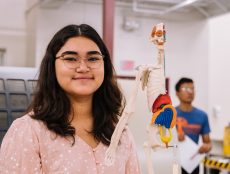Articles
Editor’s Picks
Blended Learning Is Proving More Effective Than Traditional Education
By Henry Kronk
July 06, 2018
Online learning remains unpopular amongst professors and even with the general public. While many work actively to promote the notion that an online setting can serve as an analog to in-person education, there’s a wholly less controversial use of digital technology being used in and out of the classroom. It calls for a blend of online and in-person education, and there’s growing evidence that it surpasses traditional methods. Blended learning has proven itself as not only a teaching strategy that allows greater flexibility, but one that is more effective than traditional methods.
Recent Findings from the University of Iowa
Last month, researchers from the University of Iowa presented new findings to the American Physiological Society (APS) Institute on Teaching and Learning in Madison Wisconsin. Especially among students at risk of failing a course, they found, blended learning helps boost grades.
Led by Professor Jennifer Rogers of the University of Iowa, the team investigated an undergraduate physiology course. Comparing a group of learners in a blended version versus a traditional one, Rogers’ team found evidence that overwhelmingly supported blended learning.
“Greater than 95 percent of students enrolled in the blended course section earned course grades [of] C- or higher, compared with 82 percent in the large lecture sections and 81 percent in the online sections,” Rogers told Science Daily. In addition, fewer students who took the blended version withdrew from the class and fewer reported end-of-semester anxiety.
That’s the ‘what.’ But answering the ‘why’ is less straightforward. Rogers believes that a good deal has to do with the network possible in a blended format.
“The blended course structure we utilized facilitated bidirectional information flow, fostering conversations not only between the instructor and students but among the students themselves (peer learning),” she said, according to Science Daily.
Tennessee’s Blended Learning Pilot Program
Meanwhile, the Tennessee Department of Education concluded and reported on a pilot program of blended learning this April. The initiative was tested out by 50 math teachers at 37 different schools. Put simply, students improved their test scores in each of the participating schools.

As the authors write, “Student achievement was measured by reviewing and analyzing Algebra I and Integrated Math I end-of-course (EOC) exam scores for pilot and non-pilot students. The results, taken as a whole, show a positive relationship between participating in the blended learning pilot and increased test scores. There are positive indicators for in-school comparisons between pilot students and non-pilot students as well as many subgroups.”
While they do caution that they need further data to confirm these initial results, the authors noted other benefits as well.
“Research also suggested that blended learning could impact specific subgroups, including African American students, Hispanic students, Asian students, students with disabilities, and economically disadvantaged students,” the authors write.
While Professor Rogers saw value in the peer network created via blended learning, Tennessean educators found more freedom to explore different means of teaching the same lesson.
“Qualitative and quantitative data collected throughout the course of the pilot suggests that teachers indeed used differentiated instruction more because of technology and blended learning implementation. Teachers said that access to more technology, training, and support allowed them to incorporate more blended learning activities, like online videos and applications, into their classroom. This increased the amount of differentiation in their classrooms, because students could engage with content independently.”
Not All Results of Blended Programs Are So Positive
A critic might easily say that these two studies have been cherrypicked out of a body of research that doesn’t reflect the same unilateral results, and that would be fair. For every study on blended learning that finds strong results, there’s another that reports just a small benefit. But at the same time, it’s rare to find one that reports any negative findings. There is good reason to believe that the pedagogy–especially if poorly implemented–will not show the same glowing outcomes as the studies mentioned above. But if one’s experience is like the myriad educators around the world, it won’t do much harm either.
Cover Image: rawpixel, Unsplash.









[…] can be hard to get a startup off the ground. No matter how passionate you are about something, there can be potential clients who are looking […]
[…] can be hard to get a startup off the ground. No matter how passionate you are about something, there can be potential clients who are looking […]
[…] can be hard to get a startup off the ground. No matter how passionate you are about something, there can be potential clients who are looking […]
[…] 2.3 percent of all capital raised, we beat the odds. Amidst a global pandemic, my team successfully raised a seed round in […]
[…] of all capital raised, we beat the odds. In the midst of a global pandemic, my team succeeded raised a seed round In […]
[…] 2.3 percent of all capital raised, we beat the odds. Amidst a global pandemic, my team successfully raised a seed round in […]
[…] 2.3 percent of all capital raised, we beat the odds. Amidst a global pandemic, my team successfully raised a seed round in […]
[…] 2.3 percent of all capital raised, we beat the odds. Amidst a global pandemic, my team successfully raised a seed round in […]
[…] 2.3 percent of all capital raised, we beat the odds. Amidst a global pandemic, my team successfully raised a seed round in […]
[…] 2.3 percent of all capital raised, we beat the odds. Amidst a global pandemic, my team successfully raised a seed round in […]
[…] 2.3 percent of all capital raised, we beat the odds. Amidst a global pandemic, my team successfully raised a seed round in […]
[…] the extreme changes endured by families as a result of responses to the coronavirus pandemic, the emotional and social needs of children are more prominent than ever. As we move into the new year, traditional classrooms are […]
[…] 2.3 percent of all capital raised, we beat the odds. Amidst a global pandemic, my team successfully raised a seed round in […]